Family : Brassicaceae

Text © Prof. Pietro Pavone

English translation by Mario Beltramini
Brassica napus L. is a species commonly known as Rapeseed, Rutabaga, Oilseed rape, Swede cabbage.
Its origins are uncertain, but it is very likely that it is native to the temperate zones of Mediterranean Europe and of Asia.
The name of the genus comes from the Latin term of the cabbage, introduced in literature by Plautus (III-II century BC), but the origin of the name remains uncertain, probably dating back to the Greek name Βράσκη (braske) or to the Celtic bresic (cabbage). The specific epithet reported by Theophrastus comes from the Latin name (navone), derived in turn from the Greek νᾶπυ nápu (mustard).
The rapeseed is a species cultivated in Europe, in northern Asia, in Japan, Korea, China, Russia, in southern Africa and in North America, in Australia and in New Zealand. It is also diffused in many areas as naturalized species having escaped cultivation.
Brassica napus has formed about 12 million years ago by hybridization and comes from the fusion of two genomes, that of Brassica oleracea (with genome CC, base number x=9) and that of Brassica rapa (with genome AA, base number x=10) and therefore has an allotetraploid genome (AACC) with base number x=19. Recent molecular studies taking into consideration the evolutionary speed of the gene sequences estimate that this hybrid may have formed between 6-7 thousand years ago and 38-51 thousand years ago.
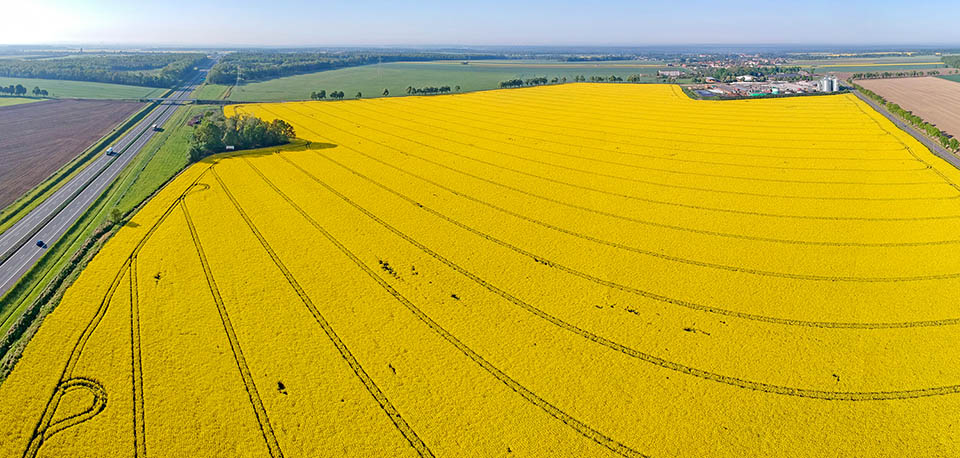
An immense field cultivated with Rapeseed (Brassica napus). The world production of rapeseeds is of about 68 million tons per year © Jarek B
Moreover, some molecular data comparing the various molecules of DNA such as the markers RFLP (Restriction Fragment Length Polymorphism) and AFLP (Amplified Fragment Length Polymorphism) indicate an origin from various independent hybridization events, but it’s still not known if the progenitors of Brassica napus were domesticated or wild.
Furthermore, the various analyses of the genomes of the chloroplasts and of the mitochondria, lead us to believe that between the progenitors of Brassica napus may stand, as maternal donors, other species, unknown to us, of Brassica with haploid kit x=9, but do not exclude that Brassica rapa (x=10) can be the maternal parent of Brassica napus.
Finally, are not known really wild populations of Brassica napus and its origin and the improvement processes done by the man are still unclear.
The cultivation of the rapeseed began 4.000 years BC in India and about 2.000 years ago in China and in Japan. In Europe, cultivation began around the XIII century and then intensified starting from 1700.
Nowadays Brassica napus is diffused all over the world and is cultivated for the production of fuel oil and of the cattle fodder.
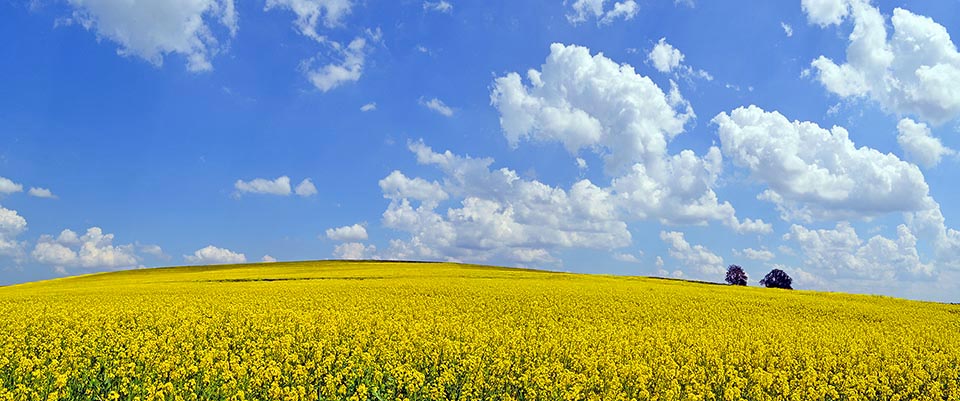
This plant cultivation began 4000 years BC. in India and about 2000 years ago in China and Japan. In Europe has begun around the XIII century © Jean-Marc Fondeur
Hence, the seeds represent the most important commercial part of the plant. As an average they contain 45% of oil, 25% of proteins, 5-7% of fibre, 4-8% of glucosinolates.
In Europe and in Asia the winter cultivation prevails due to the necessity of the plant to be exposed to the cold (vernalization) so that the flowering process can begin. As a matter of fact, sowing is done in autumn, the young plant forms the basal rosette in winter and in the following spring it produces the floral scape and the blooming that normally takes place in late spring. The fruitification begins after 6-8 weeks and can last up to mid-summer.
Besides winter ecotypes, having vernalization exigencies, do exist also spring ecotypes
Brassica napus is an annual or biennial species and presents erect stems, simple or ramified, glabrous or little hairy that can be 1,3 m tall. In the biennial forms the basal leaves are arranged in rosette with 15 cm long (often winged) petioles, lyrate-pinnatifid 5-25 cm lamina, partially lobate, and with glabrous or scarcely hairy surface. The cauline leaves are waxy, sessile with auriculate base, amplexicaul and with entire margins and glabrous lower pagina. The inflorescences are racemes forming on the main and axillary branches. Blooming begins from the base of the inflorescence.
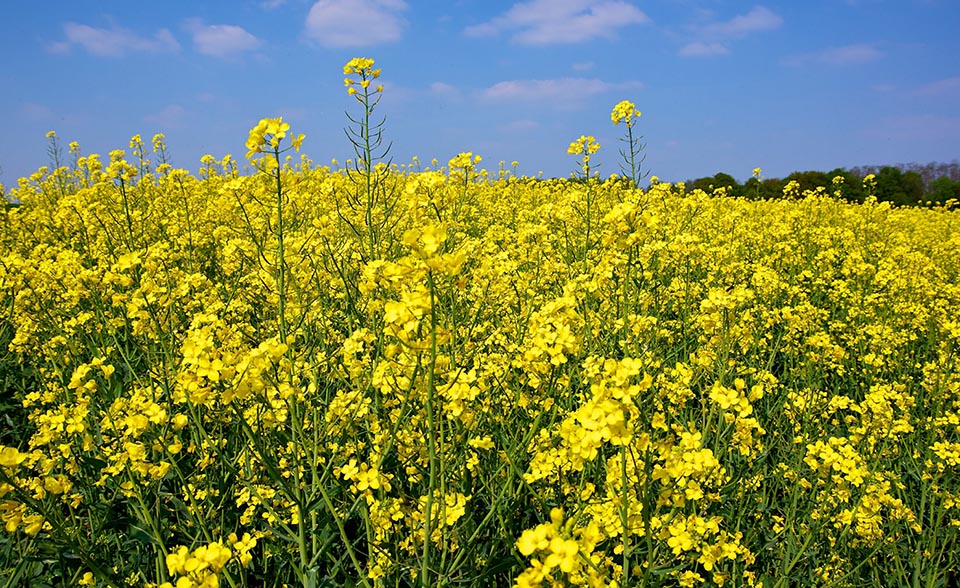
This species origins are unsure but quite probably it is native to the Mediterranean Europe and and Asian temperate zones © Philippe Lemaire
The flowers are regular, of pale yellow colour, with four 6-10 x 1,5-2,5 mm sepals, and four, 10-16 x 6-9 arranged in a cross, widely obovate, petals with 5-9 mm claw and rounded apex. The stamens are tetradynamous, that is four long and two short and with 1,5-2,5 mm anthers and 7-10 mm filaments. The ovary is superior. The flowers are pollinated by Apoidea of the genera Bombus and Apis. In the continental Europe countries, there is an important production of honey by Apis mellifera, in Italy, in the zones of cultivation, are obtained unifloral honeys as well as spring polyfloral ones. After the fecundation, the petals fall and are formed fruits that are cylindrical 60-100 x 2,5-4 mm siliquae, sessile, linear with light constrictions, attenuated in a 10-16 mm conical beak. The seeds, arranged in only one row in the fruit, are spherical in number of 12-18 per each cavity, usually of dark brown colour measuring 1,2-1,8 mm. Their tegument is reticulate-alveolate and if wet are not mucilaginous. The senescence of the leaves begins with the ripening of the siliquae and their fall begins from those placed lower.
The cotyledons are bent longitudinally around the radicle in the seed (conduplicate).
The plant grows in clayey soils organically rich, with pH between 6 and 7, drained but constantly humid and in full sun even if it tolerates the light shade and withstands winter temperatures up to – 12 °C.
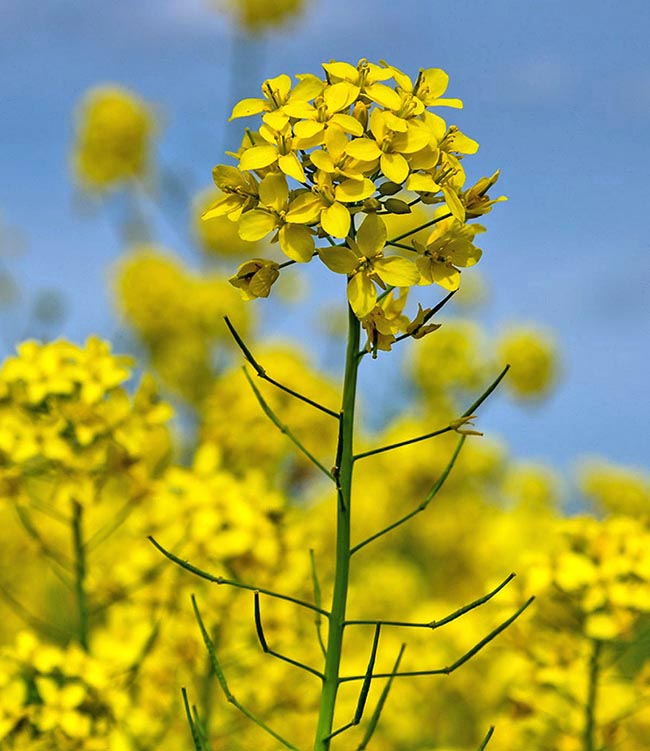
Winter cultivation prevails in Eurasia because the plant is to be exposed to cold to start the blooming process © Bram van Broekhoven
Only two subspecies are recognized:
Brassica napus subsp. napus L. (rapeseed) is an annual plant with thin roots, widely cultivated for the production of oil seeds. It easily escapes the cultivation, naturalizing in the not cultivated grounds.
Brassica napus subsp. rapifera Metzg. ex Sinskaya, called rutabaga or Swede cabbage, is biennial with fleshy roots and rarely escapes the cultivation.
Processes of genetic improvement have been done, during the cultivation, increasing the yield in oil seeds, the resistance to diseases and eliminating or reducing in the seeds the unwanted substances such as the erucic acid and the aliphatic glucosinolate. In fact, the ingestion of oils containing erucic acid may lead during the years to the arising of the disease called lipidosis of the myocardium with consequent cardiac injuries.
The first variety, called Cambra from “Canadian Brassica”, with a low content of erucic acid and of glucosinolate was obtained in Canada in 1974 with recourse to the UV rays.
Later on, they obtained other varieties of rapeseed with seeds having a lower content of erucic acid and in 1980 they reached the production of the so-called “Canola” (Canadian Oil Low Acid) with less than 2% of erucic acid.
Because of these characteristics, this variety of rapeseed has been diffused in the whole world. It is almost free of erucic acid and produces oil for human feeding.
For the non-food industry are utilized the old varieties with high content of erucic acid as from it is obtained the erucamide (C22H43NO) that is employed in the sector of the “food packaging” for the production of food containers. The main danger of this use comes from the possible risk of migration of the erucamide from the polymeric material of the container to the foodstuffs with which it can come in contact and contaminate them being a potentially toxic substance.
Depending on the content of erucic acid and of glucosinolates, we distinguish four varietal types:
– A “double high”: high content of erucic acid and glucosinolates;
– B “0”: low acid content;
-C “00” or “double zero”: with an almost nil content of erucic acid;
-D “000”: low content of erucic acid and glucosinolates and low content in fibre.
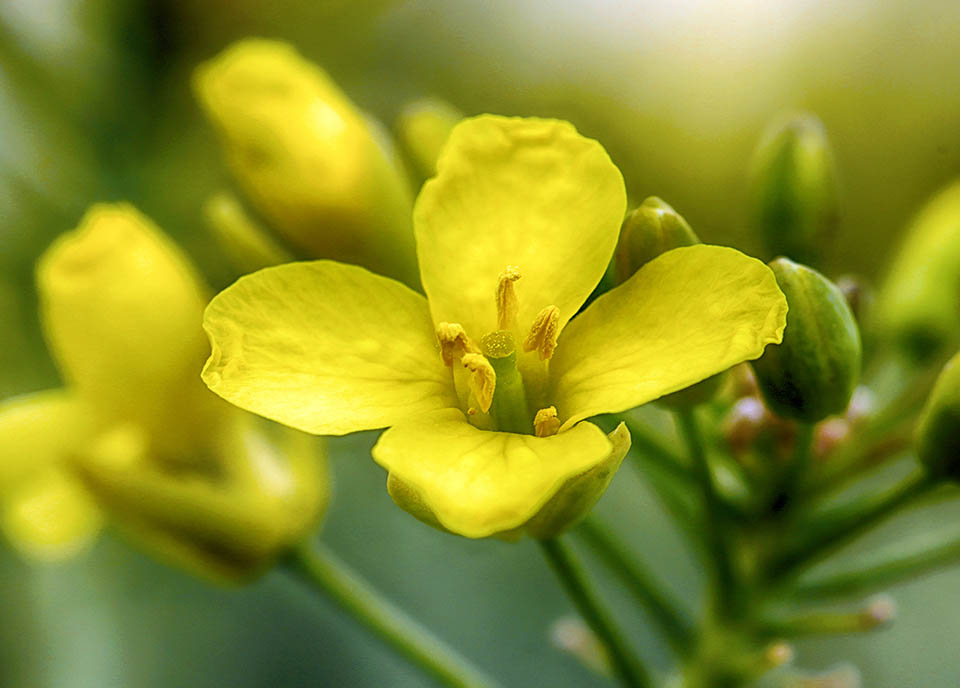
Sowing is done in autumn, the basal rosette forms in winter and blooming occurs normally in late spring © Dominique Fillion
For the flours intended for zootechnical use the community regulations prescribe the absence of erucic acid from the oil extracted and a maximum of 30 micromoles [µmol] of glucosinolates per gram of air-dried flour.
In 1995 the Monsanto Company created the first variety of genetically modified rapeseed able to resist herbicides with glufosinate-ammonium (phosphinothricin).
Since then, the traits of tolerance to the herbicides (HT, Herbicide Tolerance) have been developed for four active principles present in the herbicides: glyphosate, glufosinate-ammonium, bromoxynil and imidazoline.
The tolerance has been obtained by introducing gene of other organisms in the genome of B. napus, through technologies of the recombinant DNA, whilst only the tolerance to the imidazoline has been obtained by mutagenesis, that is by chemical-physical processes that have determined the resistance modifying the genetic code.
The rapeseed is now classified among the best oilseed crops in the world. The by-product of the cracking process for the extraction of oil from the seeds is widely utilized as fodder for livestock, poultry, pigs and fishes.
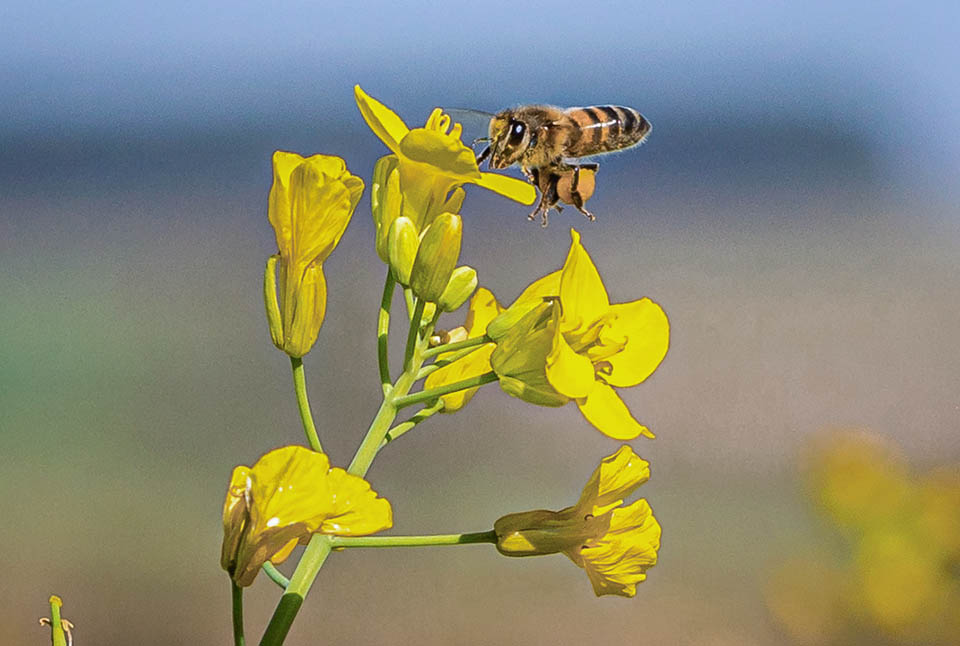
Flowers are pollinated by the genera Bombus and Apis. The bee honey quickly crystallizes and is added in very small doses to other honeys to get a creamy product © Wenderson AraujoTriluxCNA
The rapeseed produces a lot of nectar from which the bees get a honey clear but pungent that crystallizes quickly already in the honeycomb and therefore it is to be extracted immediately after the production. On the other hand, its tendency to crystallize renders it suitable for being added in very small quantities to other honeys for obtaining a good and creamy honey.
The rapeseed also has phytotherapy properties. The root and the seeds have antibacterial properties thanks to the presence of thioglycosides.
Rapeseed oils are recommended for those suffering from asthenic syndrome or having nervous system disorders. They are also an excellent diuretic and increase the production of gastric juices stimulating the appetite. The flowers improve the immune system and have positive effects on the genitourinary system. The leaves add a spicy taste to the cooking dishes and are rich in vitamin C and organic acids. In Australia and in New Zealand the plant is used in stews, soups and as flavour enhancer.
The juice of the leaves helps in healing and disinfecting wounds. Recently, it has been demonstrated that the rapeseed improves sleep, fights chronic diseases, increases the level of oxygen in the cerebral tissue and tones up the whole body.
The rapeseed oil is also a good alternative fuel to oil.
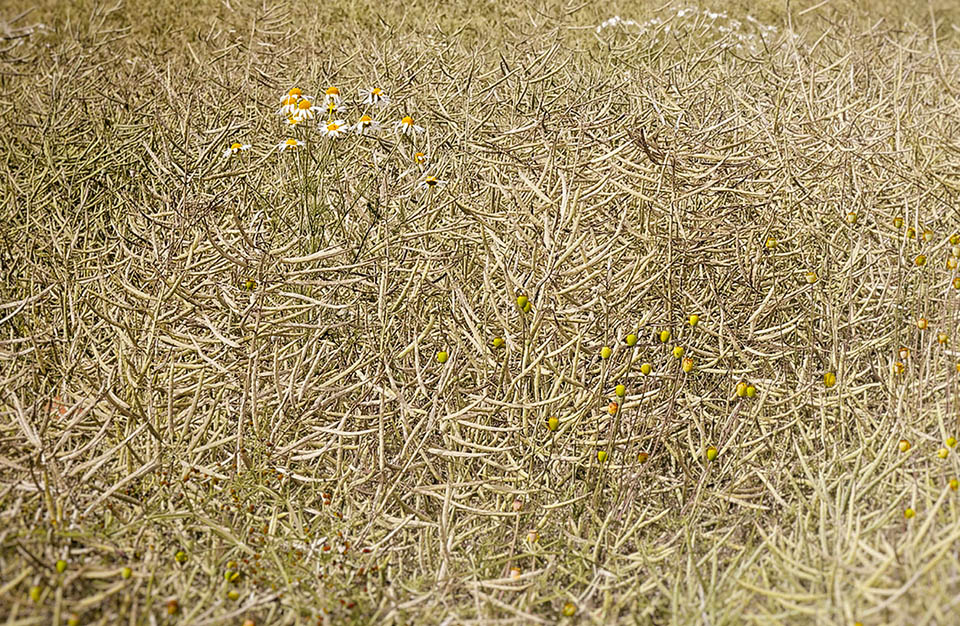
Fruitification occurs after 6-8 weeks and can last until mid-summer. besides winter ecotypes, with vernalization exigencies, do exist also spring ecotypes © Ralf Westhues
The world production of rapeseed seeds amounts to about 68 million tons per year. Here is the list of the main productive countries and in brackets the millions of tons produced. Canada (15,5), China (14,8), India (6,2), Germany (5,5), France (3,8), Australia (3,3), Poland (2,5), United Kingdom (2,2). Then come Ukraine, Czech Republic, USA, Russia, Romania, Denmark, Belarus, Hungary and Lithuania for a total of 7,6 million tons.
Nowadays, most of the oil of Canola present in the world market is of OGM origin and is widely present in the packaged food products.
Without going into the merits of the debate among those who support the benefits and who, on the contrary, highlight the negative aspects, we point out that the gene present in the varieties genetically modified is, probably, the main responsible of the reduction of the number of bees.
The intensive cultivation of Brassica napus is subject to numerous diseases caused by several agents: fungi, insects, bacteria.
In Canada by the end of the nineties of the last century there were selected cultivars having a genetic resistance to the fungal pathogen Leptosphaeria maculans (Sowerby) P.Karst.
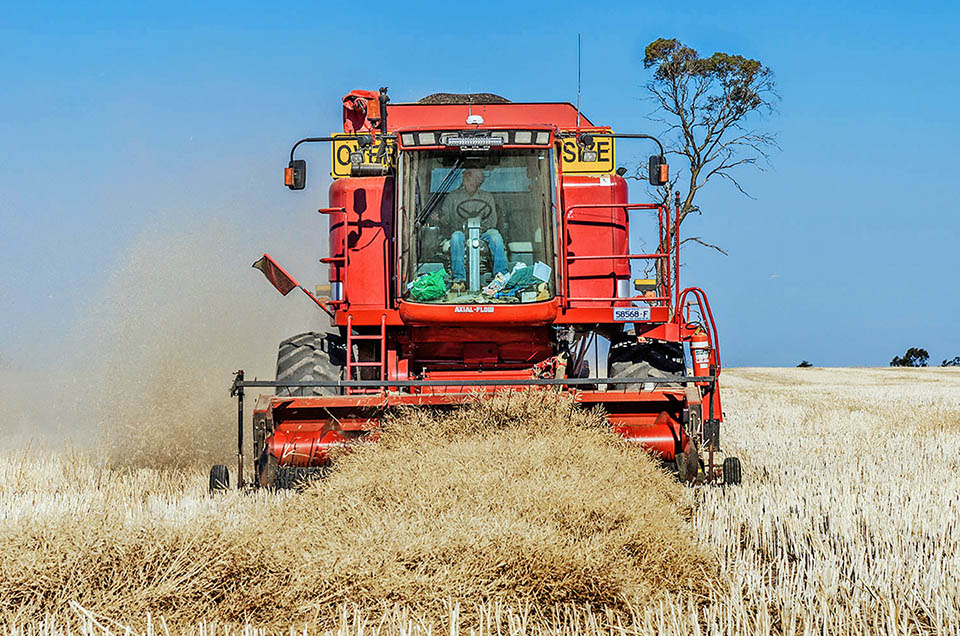
Mechanical harvest. With genetic improvement yield in oilseeds has increased, eliminating or reducing the presence of noxious substances and resistance to diseases © Beverley Pohlner
The cultivar resistant to Plasmodiophora brassicae Woronin called “CR” (clubroot-resistant), was furnished to the farmers in 2009, quickly followed by many others. however, the pathogen, that infects the roots, in turn has developed resistance to this variety, therefore, it has been necessary to modify also the agronomic practices by improving the drainage as well as by introducing the use of the lime in order to increase the pH of the soil limiting the development of the disease.
The rapeseed is subject also to the cancer of the stem, mycosis known as “blackleg disease”, caused by Phoma lingam (Tode ex Fr.) Desm. The fungi Alternaria brassicae (Berk.) Sacc. and A. brassicicola (Schwein.) Wiltshire cause leaves to dry out.
Other pathogenic fungi that can cause damage to the cultivations of rapeseed are Sclerotinia sclerotiorum (Lib.) De By. and Peronospora brassicae Gaumann.
Among the insects we mention the lepidopteran “cabbage white” (Papilio rapae L. 1758), the coleopteran “cabbage-stem flea beetle” (Psylliodes chrysocephala L., 1758), the coleopteran “stem punter” (Ceutorhynchus napi Gyllenhal, 1837), and the “weevil cabbage stem” (C. quadridens Germar, 1824) , the beetle “rape pollen beetle” (Brassicogethes aeneus Fabricius, 1775) , the fly “brassica pod midge” (Dasineura brassicae Winnertz, 1853) and the “leaf miner” (Scaptomyza flava Fallén, 1823) .
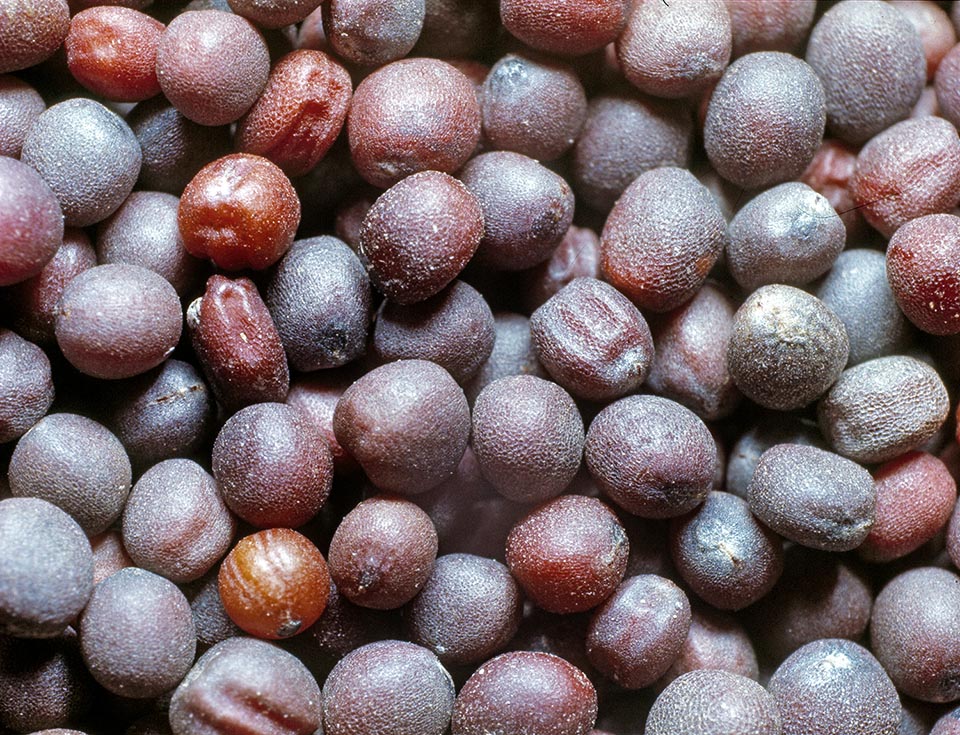
Rapeseed is classified among the world’s best crops of oily seeds. Food plant with proven and promising medicinal virtues. The flowers improve the immune system and the plant has also a vast employment in the production of feed for livestock, poultry, pigs and fishes. Finally, rapeseed oil is also a good fuel alternative to oil © Giuseppe Mazza
The swede midge (Contarinia nasturtii, Kieffer, 1888) is a small fly whose larvae infest the plants of rapeseed causing damage with twists to the stems and to the leaves. This small fly is native to Europe and to Turkey and has been introduced in northern America, where it is very harmful. Finally, we mention Xanthomonas campestris pv. campestris (Pammel) Dowson, a gram-negative bacterium that, through the foliar surface, spreads all over the plant through the wood vessels and causes the black rot, one of the most destructive diseases of the rapeseed and of the other crucifers cultivated in all the world.
Synonyms: Brassica rugosa (Roxb.) L. H. Bailey, Brassica napus subsp. oleifera (Moench) Metzg. ex Sinskaya, Brassica napus subsp. pabularia (DC.) Janch., Brassica napus var. oleifera (Moench) Delile, Brassica napus var. sahariensis A. Chev., Brassica oleifera Moench, Brassica praecox Kit. ex Hornem., Napus oleifera (Moench) K.F. Schimp. & Spenn., Rapa napus (L.) Mill., Raphanus napus (L.) Crantz, Sinapis napus (L.) Brot.; Brassica campestris var. rutabaga DC., Brassica napobrassica (L.) Mill., Brassica napus subsp. napobrassica (L.) Jafri, Brassica napus var. napobrassica (L.) Rchb., Brassica napus var. rapifera Metzg., Brassica oleracea var. napobrassica L., Brassica rutabaga (DC.) Druce.
→ For general notions about BRASSICACEAE please click here.
→ To appreciate the biodiversity within the BRASSICACEAE family please click here.
